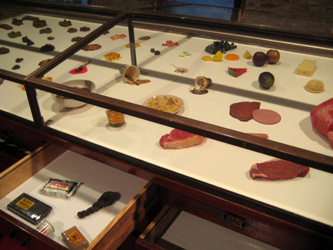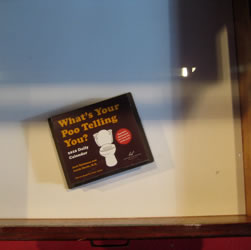

Case Space
Painting, Smoking, Eating: A Project by Richard Roth (September 13 - November 6, 2009)
Painting, Smoking, Eating is a group of small collections brought together specifically for the display case at Triple Candie. Some of the collections are new and some began more than twenty years ago. The case itself consists of two parts: on top, the large glass-enclosed surface for display and below it, seventy-two drawers. (Perhaps: consciousness above, always on view, and below, the subconscious exerting hidden influence from its darkened chambers.) In any case, this is the organizing structure of the show, which consists of objects harvested primarily from contemporary vernacular culture.
The main surface displays four collections – faux feces, faux vomit, fake spills, and replica food. All share one significant quality, they are life-size three-dimensional polychrome representations. (Inch for inch verisimilitude! The world is overflowing with replicas – models, mimics, simulations, facsimiles, and counterfeits.) The faux feces collection consists of thirty-two objects. These little brown lumps hail from all over the world, are made of numerous materials, from plastic to plaster. Most are for the gag industry (one is used for hiding house keys!). They have a subtle range of color and come in an interesting array of forms, including pretzel shapes, logs, blobs, stars, and swirls. It is worth remembering that each of these replica feces (mostly dog, including cat and unidentified) was actually modeled by a craftsperson, somewhere. Great skill and careful observation were not required (shit can’t complain about its shoddy likeness, nor does the consumer expect high realism, just props that elicit the required reaction). On the other hand, most of the replica food displayed was made by highly skilled workers. The best are the products of a Japanese company, Iwasaki Images of America, that fabricates hyper-realistic facsimiles of every imaginable food: single slices of bologna, white bread, raw and cooked meats, five varieties of ice, and scoops of chicken, and tuna salad.
The case drawers house a supporting cast of documentation and marginalia – artifacts that might only be loosely related to eating, drinking, smoking, puking, spills/accidents, defecating, and the gastrointestinal – among them, books, catalogues, quotations, and such objects as a bottle of Japanese toilet deodorizing drops, a recipe for crab balls, a Braille McDonald’s Menu, canned pork brains with milk gravy, and a “Rest Room World” catalogue.
"I ask not for the great, the remote, the romantic...I embrace the common, I explore and sit at the feet of the familiar, the low. "
– Ralph Waldo Emerson, 1837
"The contents of the bowels…clearly are treated as a part of the infant’s own body and represent his first “gift”…"
– Sigmund Freud, Three Essays on the Theory of Human Sexuality, 1962
"…In that Empire, the Art of Cartography attained such
Perfection that the map of a single Province occupied the
entirety of a City, and the map of the Empire, the entirety of a
Province. In time, those Unconscionable Maps no longer
satisfied, and the Cartographers Guilds struck a Map of the
Empire whose size was that of the Empire, and which coincided
point for point with it."
– From On Exactitude in Science, by Jorge Luis Borges, 1960
The title, Painting, Smoking, Eating, is borrowed from Philip Guston.
Richard Roth
August 2009


